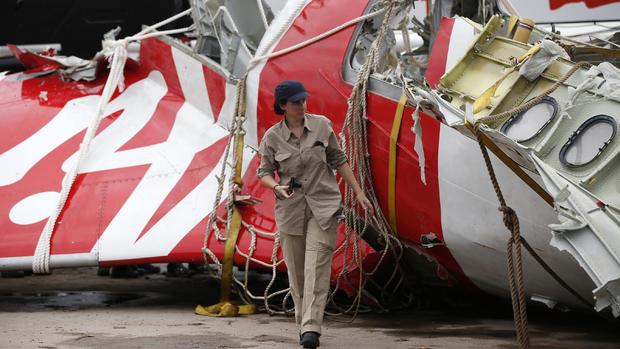AirAsia Flight 8501: Plane climbed fast before crash, official says
JAKARTA, Indonesia - Indonesia's transport minister says an AirAsia plane that crashed last month with 162 people on board was climbing at an abnormally high rate, then plunged and suddenly disappeared from radar.
Ignasius Jonan told Parliament that radar data showed the Airbus A320 was climbing at about 6,000 feet a minute before it disappeared on Dec. 28.
"It is not normal to climb like that, it's very rare for commercial planes, which normally climb just 1,000 to 2,000 feet per minute," he said. "It can only be done by a fighter jet."
He said the plane then plunged toward the sea and disappeared from radar.
In their last contact with air-traffic controllers, the pilots of AirAsia Flight 8501 asked to climb from 32,000 feet to 38,000 feet to avoid threatening clouds, but were denied permission because of heavy air traffic. Four minutes later, the plane disappeared. No distress signal was received.
An excessively rapid ascent is likely to cause an airplane to go into an aerodynamic stall. In 2009, an Air France Airbus A330 disappeared over the Atlantic Ocean in bad weather while flying from Rio de Janeiro to Paris. Investigators were able to determine from the jet's "black boxes" that it began a steep climb and then went into a stall from which the pilots were unable to recover.
Airbus spokesman Justin Dubon said Tuesday that it was too early to comment on possible similarities between the two crashes.
The AirAsia plane had 162 people on board when it disappeared en route from Surabaya, Indonesia, to Singapore. Nearly all passengers and crew were Indonesian.
Only 53 bodies have been recovered so far. Rough sea conditions have repeatedly prevented divers from reaching the wreckage.
Survey ships have located at least nine big objects, including the jet's fuselage, in the Java Sea.
The crashed AirAsia jet's fuselage will be lifted to the surface after sea conditions again prevented divers from examining the large chunk of wreckage.
Both "black boxes" from the plane have been retrieved and are being examined for clues about why the plane went down. Bad weather is so far suspected as being the reason.
The information obtained from the black boxes - which are actually orange - will likely be vital. Designed to survive extreme heat and pressure, they should provide investigators with a second-by-second timeline of the flight.
"So far, we've managed to download and transcribe half of the cockpit voice recorder," said Nurcahyo Utomo, a commissioner with the National Transportation Safety Committee. "It is too early to draw any conclusion yet because we don't know what is in the remaining half."
The voice recorder captures all conversations between the pilots and with air traffic controllers, as well as any noises in the cockpit, including possible alarms or explosions. The flight data recorder saves information on the position and condition of almost every major part in the plane, including altitude, airspeed, direction, engine thrust, rate of ascent or descent and what up-or-down angle the plane is pointed.
